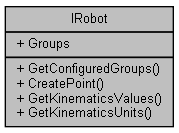Inherits IDispatch.

Classes | |
| struct | GroupRef |
| struct | KinematicsUnits |
| struct | KinematicsValues |
| struct | RobotAxisConfiguration |
| struct | RobotBeltConfigValues |
| struct | RobotBeltErrorReactionValues |
| struct | RobotInformation |
| struct | RobotMechanicData |
| struct | RobotPerformanceResult |
| struct | RobotTrafoParameter |
Public Types |
Public Member Functions | |
| HRESULT | GetConfiguredGroups ([out, retval] SAFEARRAY(struct RobotInformation)*robotsInfo) |
| HRESULT | CreatePoint ([in] SAFEARRAY(DOUBLE) point, [in, defaultvalue(ROBOT_CS_MCS)] enum RobotCoordinateSystem type, [out, retval] IRobotPoint **retPoint) |
| HRESULT | GetKinematicsValues ([in]SAFEARRAY(struct GroupRef) Groups, [out, retval] SAFEARRAY(struct KinematicsValues)*kinematicsValues) |
| HRESULT | GetKinematicsUnits ([in]SAFEARRAY(struct GroupRef) Groups, [out, retval] SAFEARRAY(struct KinematicsUnits)*kinematicsUnits) |
Properties | |
| IGroups | Groups [get] |
Definition of the IRobot interface which gives access to the robot control functionality of the MLPI Device.
The IRobot interface is not implemented, yet. This is only a placeholder.
Definition at line 70 of file IRobot.idl.
This enumeration defines the types of axis used in a robot. This is parameter K-0-0008.
Definition at line 74 of file IRobot.idl.
| enum IRobot::RobotTypes |
This enumeration defines the type of robot.
| Enumerator | |
|---|---|
| ROBOT_TYPE_RHO |
Old robot control core. |
| ROBOT_TYPE_RCF |
RCF robot control core. |
Definition at line 84 of file IRobot.idl.
| enum IRobot::RobotSetMode |
This enumeration defines the set mode for robot motion commands.
| Enumerator | |
|---|---|
| ROBOT_SETMODE_TO |
no blending |
| ROBOT_SETMODE_VIA |
blending |
Definition at line 92 of file IRobot.idl.
This enumeration defines the type of performance measurement.
| Enumerator | |
|---|---|
| ROBOT_PERFORMANCE_ENABLE |
Enable measurement. |
| ROBOT_PERFORMANCE_DISABLE |
Disable measurement. |
Definition at line 100 of file IRobot.idl.
This enumeration defines the type of performance measurement.
Definition at line 108 of file IRobot.idl.
This enumeration defines the slope type for robot motion commands.
| Enumerator | |
|---|---|
| ROBOT_SLOPETYPE_BLOCK_SLOPE |
blending by starting next command early |
| ROBOT_SLOPETYPE_PROGR_SLOPE |
blending using a circle (deprecated) |
| ROBOT_SLOPETYPE_CONT_SLOPE |
blending using a spline |
Definition at line 133 of file IRobot.idl.
This enumeration defines error reaction mode of a belt.
Definition at line 142 of file IRobot.idl.
| enum IRobot::RobotMechCmd |
This enum defines the command for an mechanical object.
Definition at line 151 of file IRobot.idl.
| enum IRobot::RobotCSType |
This enum defines whether the coordinate system of a transformation is Cartesian or cylindric.
| Enumerator | |
|---|---|
| ROBOT_CS_CARTESIAN |
A Cartesian coordinate system. |
| ROBOT_CS_CYLINDRIC |
A cylindric coordinate system. |
Definition at line 162 of file IRobot.idl.
This enum defines the type of a save zone.
| Enumerator | |
|---|---|
| ROBOT_SAFE_ZONE_TYPE_DEACTIVATED |
zone deactivated |
| ROBOT_SAFE_ZONE_TYPE_INSIDE_OK |
points within this zone are allowed |
| ROBOT_SAFE_ZONE_TYPE_OUTSIDE_OK |
points outside of this zone are allowed |
Definition at line 170 of file IRobot.idl.
| HRESULT IRobot::GetConfiguredGroups | ( | [out, retval] SAFEARRAY(struct RobotInformation)* | robotsInfo | ) |
This method returns a struct array with information about the currently configured robots in the device. Use this method to get a quick overview of the robot configuration of your target. You can then use the Name or GroupRef.AxisNo element of the returned structure as an index for the IMlpiConnection::Robot property of this interface to get more information of the given robot.
| [out] | robotsInfo | Struct array containing information about the current robots configuration. Contains one element for each robot. |
| HRESULT IRobot::CreatePoint | ( | [in] SAFEARRAY(DOUBLE) | point, |
| [in, defaultvalue(ROBOT_CS_MCS)] enum RobotCoordinateSystem | type, | ||
| [out, retval] IRobotPoint ** | retPoint | ||
| ) |
This method creates a robot point object with the given values. Use this method to create a new point. You can use this point for example to move to. Every point has coordinates and a coordinate system the point is defined in.
| [in] | point | Coordinates of the point |
| [in] | type | Coordinate system the point is defined in |
| [out] | retPoint | Created point object. |
| HRESULT IRobot::GetKinematicsValues | ( | [in] SAFEARRAY(struct GroupRef) | Groups, |
| [out, retval] SAFEARRAY(struct KinematicsValues)* | kinematicsValues | ||
| ) |
This function fills an array of IRobot::KinematicsValues structures. Use the Groups input parameter to specify the groups for which information should be read. You may want to use this method to read several sets of kinematics information for several groups using one single method call during operation of the group. This provides increased performance in comparison to reading the values bit by bit and kinematic by kinematic.
| [in] | Groups | An array of GIRobot::GroupRef structures which specify the kinematics you want to read. |
| [out] | kinematicsValues | An array of IRobot::KinematicsValues structures. |
mlpiRobotGetKinematicsValues, where you can find further documentation.mlpiRobotGetKinematicsValues, where you can find further documentation. | HRESULT IRobot::GetKinematicsUnits | ( | [in] SAFEARRAY(struct GroupRef) | Groups, |
| [out, retval] SAFEARRAY(struct KinematicsUnits)* | kinematicsUnits | ||
| ) |
This function fills an array of IRobot::KinematicsUnits structures with information about the units of the kinematics. Use the groups input parameter to specify the groups for which information should be read. This provides increased performance in comparison to reading the values bit by bit and kinematic by kinematic.
| [in] | Groups | An array of GroupRef structures which specify the kinematics you want to read. |
| [out] | kinematicsUnits | An array of IRobot::KinematicsUnits structures. |
mlpiRobotGetKinematicsUnits, where you can find further documentation.mlpiRobotGetKinematicsUnits, where you can find further documentation.
|
get |
This property returns a IGroups object which allows access to different IGroup objects, as well as access to methods which control ALL groups on the device. The IGroups interface is a collection interface.
| [out] | groups | Returns an object of the type IGroups. |